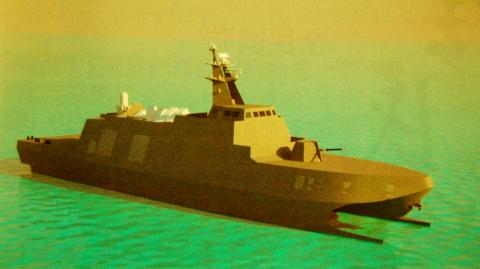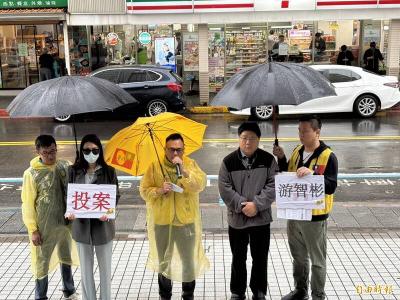Despite hitting a snag in a recent bidding process, the navy is proceeding with the development of a stealth 500-tonne fast attack missile boat that is already being hailed as Taiwan’s “carrier killer.”
Plans for the indigenous development of the 500-tonne corvette were first made public in 2009. In April the following year, Deputy Minister of National Defense Lin Yu-pao (林於豹) told the legislature that design work as part of the Hsun Hai (迅海, “Swift Sea”) program was completed and that bidding would be held this year.
The legislature last year passed a NT$24.98 billion (US$853.4 million) budget to build between seven and 11 corvettes, with delivery scheduled for 2014. The boats are reportedly expected to remain in service for 25 years.

Image provided courtesy of the Republic of China Navy
However, the process hit an obstacle last month, when only two small firms, Ching Fu Shipbuilding Co and Lung Teh Shipbuilding Co, participated in the bid for construction of the Swift Sea prototypes. China Shipbuilding Corp, Taiwan (CSBC), the nation’s largest shipbuilder, did not participate in the March 26 bid, causing it to fail, the Chinese-language Asia-Pacific Defense Magazine reported in its latest issue.
A CSBC official said the firm decided not to participate in the bid because several technological requirements for the project had yet to be confirmed by the ministry.
Once those issues have been cleared up, CSBC will participate in the bid, the official said, adding that the company was very keen on winning the contract.
The corvettes will come equipped with eight Hsiung Feng II (HF-2) and Hsiung Feng III (HF-3) anti-ship missiles, as well as a 76mm rapid-fire bow gun. The catamaran-style design, reports said, may have been inspired by the 220-tonne Houbei-class Type 022 catamaran recently deployed by China’s People’s Liberation Army Navy (PLAN).
Analysts are saying the central cross-linked structure of the Swift Sea corvette will provide high stability, adding that its 30 knot (55.5kph) speed will also be an asset. Special attention has reportedly been paid to the stealth design for the hull and main gun turret, which will use radar refractive materials
The program is seen as the logical follow-up to the development of the Kuang Hua VI (KH-6) fast-attack boats in service in the navy since 2010. In all, 31 of the CSBC-made, 170-tonne KH-6s, divided into three squadrons and which carry four HF-2s each, are active in the navy. Earlier this year, critics of the small attack craft said its light displacement and top-heavy design undermined its stability at sea, especially during unfavorable weather conditions.
James Holmes of the US Naval War College told the Taipei Times at the time that the KH-6 was probably only a transitional platform until something better was introduced.
Amid growing focus on the indigenous development of weapons systems, Taiwan appears to be slowly emphasizing an asymmetrical approach to countering the Chinese military, with less reliance on heavy — and expensive — platforms and more on speed, stealth and evasiveness, analysts say.
Taiwanese defense analysts say the principal role of the new corvettes in coastal defense will be to target any carrier battle group deployed by the PLAN in nearby waters.
China’s first aircraft carrier, the refurbished former Soviet Varyag, is expected to enter service in August this year. Two or three additional carriers are expected to be built by Chinese shipyards by 2020.

DEFENSE: The National Security Bureau promised to expand communication and intelligence cooperation with global partners and enhance its strategic analytical skills China has not only increased military exercises and “gray zone” tactics against Taiwan this year, but also continues to recruit military personnel for espionage, the National Security Bureau (NSB) said yesterday in a report to the Legislative Yuan. The bureau submitted the report ahead of NSB Director-General Tsai Ming-yen’s (蔡明彥) appearance before the Foreign and National Defense Committee today. Last year, the Chinese People’s Liberation Army (PLA) conducted “Joint Sword-2024A and B” military exercises targeting Taiwan and carried out 40 combat readiness patrols, the bureau said. In addition, Chinese military aircraft entered Taiwan’s airspace 3,070 times last year, up about

A magnitude 4.3 earthquake struck eastern Taiwan's Hualien County at 8:31am today, according to the Central Weather Administration (CWA). The epicenter of the temblor was located in Hualien County, about 70.3 kilometers south southwest of Hualien County Hall, at a depth of 23.2km, according to the administration. There were no immediate reports of damage resulting from the quake. The earthquake's intensity, which gauges the actual effect of a temblor, was highest in Taitung County, where it measured 3 on Taiwan's 7-tier intensity scale. The quake also measured an intensity of 2 in Hualien and Nantou counties, the CWA said.

The Overseas Community Affairs Council (OCAC) yesterday announced a fundraising campaign to support survivors of the magnitude 7.7 earthquake that struck Myanmar on March 28, with two prayer events scheduled in Taipei and Taichung later this week. “While initial rescue operations have concluded [in Myanmar], many survivors are now facing increasingly difficult living conditions,” OCAC Minister Hsu Chia-ching (徐佳青) told a news conference in Taipei. The fundraising campaign, which runs through May 31, is focused on supporting the reconstruction of damaged overseas compatriot schools, assisting students from Myanmar in Taiwan, and providing essential items, such as drinking water, food and medical supplies,

New Party Deputy Secretary-General You Chih-pin (游智彬) this morning went to the National Immigration Agency (NIA) to “turn himself in” after being notified that he had failed to provide proof of having renounced his Chinese household registration. He was one of more than 10,000 naturalized Taiwanese citizens from China who were informed by the NIA that their Taiwanese citizenship might be revoked if they fail to provide the proof in three months, people familiar with the matter said. You said he has proof that he had renounced his Chinese household registration and demanded the NIA provide proof that he still had Chinese